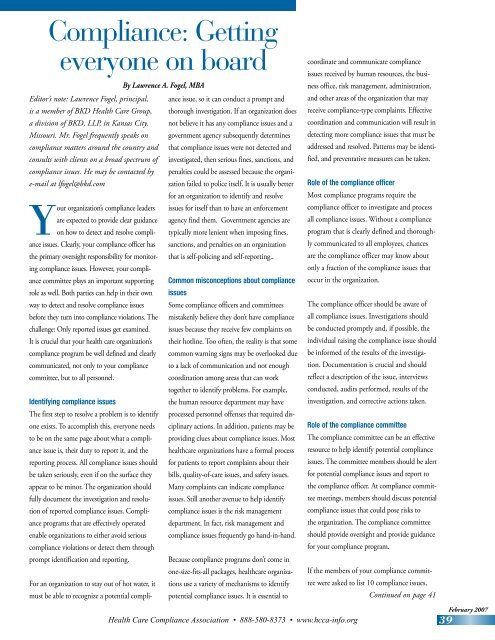Mildred L. Johnson, JD, CPC - Health Care Compliance Association
Mildred L. Johnson, JD, CPC - Health Care Compliance Association
Mildred L. Johnson, JD, CPC - Health Care Compliance Association
You also want an ePaper? Increase the reach of your titles
YUMPU automatically turns print PDFs into web optimized ePapers that Google loves.
<strong>Compliance</strong>: Getting<br />
everyone on board<br />
Editor’s note: Lawrence Fogel, principal,<br />
is a member of BKD <strong>Health</strong> <strong>Care</strong> Group,<br />
a division of BKD, LLP, in Kansas City,<br />
Missouri. Mr. Fogel frequently speaks on<br />
compliance matters around the country and<br />
consults with clients on a broad spectrum of<br />
compliance issues. He may be contacted by<br />
e-mail at lfogel@bkd.com<br />
Your organization’s compliance leaders<br />
are expected to provide clear guidance<br />
on how to detect and resolve compliance<br />
issues. Clearly, your compliance officer has<br />
the primary oversight responsibility for monitoring<br />
compliance issues. However, your compliance<br />
committee plays an important supporting<br />
role as well. Both parties can help in their own<br />
way to detect and resolve compliance issues<br />
before they turn into compliance violations. The<br />
challenge: Only reported issues get examined.<br />
It is crucial that your health care organization’s<br />
compliance program be well defined and clearly<br />
communicated, not only to your compliance<br />
committee, but to all personnel.<br />
Identifying compliance issues<br />
The first step to resolve a problem is to identify<br />
one exists. To accomplish this, everyone needs<br />
to be on the same page about what a compliance<br />
issue is, their duty to report it, and the<br />
reporting process. All compliance issues should<br />
be taken seriously, even if on the surface they<br />
appear to be minor. The organization should<br />
fully document the investigation and resolution<br />
of reported compliance issues. <strong>Compliance</strong><br />
programs that are effectively operated<br />
enable organizations to either avoid serious<br />
compliance violations or detect them through<br />
prompt identification and reporting.<br />
For an organization to stay out of hot water, it<br />
By Lawrence A. Fogel, MBA<br />
must be able to recognize a potential compliance<br />
issue, so it can conduct a prompt and<br />
thorough investigation. If an organization does<br />
not believe it has any compliance issues and a<br />
government agency subsequently determines<br />
that compliance issues were not detected and<br />
investigated, then serious fines, sanctions, and<br />
penalties could be assessed because the organization<br />
failed to police itself. It is usually better<br />
for an organization to identify and resolve<br />
issues for itself than to have an enforcement<br />
agency find them. Government agencies are<br />
typically more lenient when imposing fines,<br />
sanctions, and penalties on an organization<br />
that is self-policing and self-reporting..<br />
Common misconceptions about compliance<br />
issues<br />
Some compliance officers and committees<br />
mistakenly believe they don’t have compliance<br />
issues because they receive few complaints on<br />
their hotline. Too often, the reality is that some<br />
common warning signs may be overlooked due<br />
to a lack of communication and not enough<br />
coordination among areas that can work<br />
together to identify problems. For example,<br />
the human resource department may have<br />
processed personnel offenses that required disciplinary<br />
actions. In addition, patients may be<br />
providing clues about compliance issues. Most<br />
healthcare organizations have a formal process<br />
for patients to report complaints about their<br />
bills, quality-of-care issues, and safety issues.<br />
Many complaints can indicate compliance<br />
issues. Still another avenue to help identify<br />
compliance issues is the risk management<br />
department. In fact, risk management and<br />
compliance issues frequently go hand-in-hand.<br />
Because compliance programs don’t come in<br />
one-size-fits-all packages, healthcare organizations<br />
use a variety of mechanisms to identify<br />
potential compliance issues. It is essential to<br />
coordinate and communicate compliance<br />
issues received by human resources, the business<br />
office, risk management, administration,<br />
and other areas of the organization that may<br />
receive compliance-type complaints. Effective<br />
coordination and communication will result in<br />
detecting more compliance issues that must be<br />
addressed and resolved. Patterns may be identified,<br />
and preventative measures can be taken.<br />
Role of the compliance officer<br />
Most compliance programs require the<br />
compliance officer to investigate and process<br />
all compliance issues. Without a compliance<br />
program that is clearly defined and thoroughly<br />
communicated to all employees, chances<br />
are the compliance officer may know about<br />
only a fraction of the compliance issues that<br />
occur in the organization.<br />
The compliance officer should be aware of<br />
all compliance issues. Investigations should<br />
be conducted promptly and, if possible, the<br />
individual raising the compliance issue should<br />
be informed of the results of the investigation.<br />
Documentation is crucial and should<br />
reflect a description of the issue, interviews<br />
conducted, audits performed, results of the<br />
investigation, and corrective actions taken.<br />
Role of the compliance committee<br />
The compliance committee can be an effective<br />
resource to help identify potential compliance<br />
issues. The committee members should be alert<br />
for potential compliance issues and report to<br />
the compliance officer. At compliance committee<br />
meetings, members should discuss potential<br />
compliance issues that could pose risks to<br />
the organization. The compliance committee<br />
should provide oversight and provide guidance<br />
for your compliance program.<br />
If the members of your compliance committee<br />
were asked to list 10 compliance issues,<br />
Continued on page 41<br />
<strong>Health</strong> <strong>Care</strong> <strong>Compliance</strong> <strong>Association</strong> • 888-580-8373 • www.hcca-info.org<br />
February 2007<br />
39

















